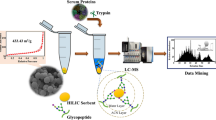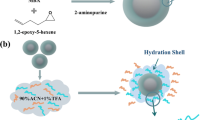Abstract
A kind of zwitterionic microsphere was prepared via one-step inverse suspension polymerization employing 3-[N,N-dimethyl-[2-(2-methylpropyl-2-enyloxy) ethyl] ammonium] propane-1-sulfonate (MSA) and N,N-methylene bisacrylamide (BIS) as the precursors. The preparation conditions were carefully investigated and optimized by regulating the content of total monomers, ratio of MSA to BIS, ratio of water to oil, and content of stabilizer. The properties of microspheres were characterized by helium ion microscopy (HIM), Fourier transform infrared spectroscopy (FT-IR), X-ray photoelectron spectroscopy (XPS), N2 adsorption/desorption measurement, and water contact angle measurement. The particle size of resulting polydisperse microspheres ranged from 15–25 μm, exhibiting high specific surface area of 138 m2 g−1. Owing to great hydrophilicity, the resulting zwitterionic microspheres could be directly used as hydrophilic interaction chromatography (HILIC) sorbent to enrich glycopeptides from biosamples without any chemical modification. A total of 19 N-glycopeptides was enriched from 10 μg of IgG digest. Besides, up to 383 N-glycopeptides and 224 N-glycosylation sites were unambiguously identified from 2 μL of human serum digest by cLC-MS/MS after enrichment with zwitterionic microspheres, indicating their great enrichment performance to N-glycopeptides. The approach of preparing hydrophilic zwitterionic microspheres contains only one synthesis reaction and is suitable for large-scale preparation.
Graphical abstract








Similar content being viewed by others
References
Sun N, Wu H, Shen X, Deng C (2019) Nanomaterials in proteomics. Adv Funct Mater 29:1900253
Chu H, Zheng H, Yao J, Sun N, Yan G, Deng C (2020) Magnetic metal phenolic networks: expanding the application of a promising nanoprobe to phosphoproteomics research. Chem Commun 56:11299–11302
Magalhaes A, Duarte HO, Reis CA (2017) Aberrant glycosylation in cancer: a novel molecular mechanism controlling metastasis. Cancer Cell 31:733–735
Ohtsubo K, Marth JD (2006) Glycosylation in cellular mechanisms of health and disease. Cell 126:855–867
Krueger KE, Srivastava S (2006) Posttranslational protein modifications: current implications for cancer detection, prevention, and therapeutics. Mol Cell Proteomics 5:1799–1810
Zhang Y, Fonslow BR, Shan B, Baek MC, Yates JR (2013) Protein analysis by shotgun/bottom-up proteomics. Chem Rev 113:2343–2394
Alvarez-Manilla G, Atwood J, Guo Y, Warren NL, Orlando R, Pierce M (2006) Tools for glycoproteomic analysis: size exclusion chromatography facilitates identification of tryptic glycopeptides with N-linked glycosylation sites. J Proteome Res 5:701–708
Qing G, Yan J, He X, Li X, Liang X (2020) Recent advances in hydrophilic interaction liquid interaction chromatography materials for glycopeptide enrichment and glycan separation. TrAC-Trend Anal Chem 124:115570
Li K, Zhao B, Yu Q, Xu J, Li X, Wei D, Qian L, Liu G, Wang W (2020) Porous graphene oxide/chitosan beads with honeycomb-biomimetic microchannels as hydrophilic adsorbent for the selective capture of glycopeptides. Microchim Acta 187:324
Liu Y, Fu D, Yu L, Xiao Y, Peng X, Liang X (2016) Oxidized dextran facilitated synthesis of a silica-based concanavalin a material for lectin affinity enrichment of glycoproteins/glycopeptides. J Chromatogr A 1455:147–155
Li H, He H, Liu Z (2021) Recent progress and application of boronate affinity materials in bioanalysis. TrAC-Trend Anal Chem 140:116271
Nilsson J, Ruetschi U, Halim A, Hesse C, Carlsohn E, Brinkmalm G, Larson G (2009) Enrichment of glycopeptides for glycan structure and attachment site identification. Nat Methods 6:809–813
Huang J, Wang F, Ye M, Zou H (2014) Enrichment and separation techniques for large-scale proteomics analysis of the protein post-translational modifications. J Chromatogr A 1372:1–17
Man-Kupisinska A, Bobko E, Gozdziewicz TK, Maciejewska A, Jachymek W, Lugowski C, Lukasiewicz J (2016) Fractionation and analysis of lipopolysaccharide-derived oligosaccharides by zwitterionic-type hydrophilic interaction liquid chromatography coupled with electrospray ionisation mass spectrometry. Carbohydr Res 427:29–37
Zhang N, Hu X, Chen H, Deng C, Sun N (2021) Specific enrichment and glycosylation discrepancy profiling of cellular exosomes using a dual-affinity probe. Chem Commun 57:6249–6252
Sun NR, Wang JW, Yao JZ, Deng CH (2017) Hydrophilic mesoporous silica materials for highly specific enrichment of N-linked glycopeptide. Anal Chem 89:1764–1771
Miao WL, Zhang C, Cai Y, Zhang Y, Lu HJ (2016) Fast solid-phase extraction of N-linked glycopeptides by amine-functionalized mesoporous silica nanoparticles. Analyst 141:2435–2440
Hu X, Wu Y, Deng C (2020) Recognition of urinary N-linked glycopeptides in kidney cancer patients by hydrophilic carbohydrate functionalized magnetic metal organic framework combined with LC-MS/MS. Microchim Acta 187:616
Li X, Zhang H, Zhang N, Ma S, Ou J, Ye M (2019) One-step preparation of zwitterionic-rich hydrophilic hydrothermal carbonaceous materials for enrichment of N-glycopeptides. ACS Sustain Chem Eng 7:11511–11520
Liu Z, Peng Y, Wang T, Yuan G, Zhang Q, Guo J, Jiang Z (2013) Preparation and application of novel zwitterionic monolithic column for hydrophilic interaction chromatography. J Sep Sci 36:262–269
Chu H, Hu X, Yao J, Yan G, Sun N, Deng C (2020) One-pot preparation of hydrophilic citric acid-magnetic nanoparticles for identification of glycopeptides in human saliva. Talanta 206:120178
Li Y, Wang H, You X, Ma S, Dong J, Wei Y, Ou J, Ye M (2018) Facile preparation of microporous organic polymers functionalized macroporous hydrophilic resin for selective enrichment of glycopeptides. Anal Chim Acta 1030:96–104
Ma S, Zhang L, Wang S, Zhang H, You X, Ou J, Ye M, Wei Y (2019) Preparation of epoxy-functionalized hierarchically porous hybrid monoliths via free radical polymerization and application in HILIC enrichment of glycopeptides. Anal Chim Acta 1058:97–106
Zhang L, Ma S, Chen Y, Wang Y, Ou J, Uyama H, Ye M (2019) Facile fabrication of biomimetic chitosan membrane with honeycomb-like structure for enrichment of glycosylated peptides. Anal Chem 91:2985–2993
Zhang N, Dong J, Li X, Wang S, Ou J, Ye M (2020) One-step synthesis of hydrophilic microspheres for highly selective enrichment of N-linked glycopeptides. Anal Chim Acta 1130:91–99
Dai N, Wang S, Li H, Zhao L, Jin H, An N, Gong P, Tan Q, Tang X, Wang F, Zhang R (2019) Fabrication of poly(glycidyl methacrylate-co-ethylene glycol dimethacrylate) macroporous microspheres through activators regenerated by electron transfer atom transfer radical polymerization for rapid separation of proteins. J Chromatogr B Analyt Technol Biomed Life Sci 1128:121794
Gong Y, Liu QL, Zhu AM, Zhang QG (2012) One-pot synthesis of poly(n-isopropylacrylamide)/chitosan composite microspheres via microemulsion. Carbohydr Polym 90:690–695
Sheng Q, Su X, Li X, Ke Y, Liang X (2014) A dextran-bonded stationary phase for saccharide separation. J Chromatogr A 1345:57–67
Mulani K, Patil V, Chavan N, Donde K (2019) Adsorptive removal of chromium(VI) using spherical resorcinol-formaldehyde beads prepared by inverse suspension polymerization. J Polym Res 26:41
Chen S, Mo F, Stadler FJ, Chen S, Ge Z, Zhuo H (2015) Development of zwitterionic copolymers with multi-shape memory effects and moisture-sensitive shape memory effects. J Mater Chem B 3:6645–6655
Ren H, Mei Z, Chen Y, Chen S, Ge Z, Hu J (2017) Synthesis of zwitterionic acrylamide copolymers for biocompatible applications. J Bioact Compat Pol 33:3–16
Chen Y, Xiong Z, Zhang L, Zhao J, Zhang Q, Peng L, Zhang W, Ye M, Zou H (2015) Facile synthesis of zwitterionic polymer-coated core-shell magnetic nanoparticles for highly specific capture of N-linked glycopeptides. Nanoscale 7:3100–3108
Pang Q, Tang J, Huang H, Liang X, Hart C, Tam KC, Nazar LF (2015) A nitrogen and sulfur dual-doped carbon derived from polyrhodanine@cellulose for advanced lithium-sulfur batteries. Adv Mater 27:6021–6028
Zhang P, Zhang N, Wang Q, Wang P, Yuan J, Shen J, Fan X (2019) Disulfide bond reconstruction: a novel approach for grafting of thiolated chitosan onto wool. Carbohydr Polym 203:369–377
Chao G, Zhang L, Wang D, Chen S, Guo H, Xu K, Fan W, Liu T (2020) Activation of graphitic nitrogen sites for boosting oxygen reduction. Carbon 159:611–616
Xia C, Jiao F, Gao F, Wang H, Lv Y, Shen Y, Zhang Y, Qian X (2018) Two-dimensional MoS2-based zwitterionic hydrophilic interaction liquid chromatography material for the specific enrichment of glycopeptides. Anal Chem 90:6651–6659
Tian Y, Tang R, Liu L, Yu Y, Ma S, Gong B, Ou J (2020) Glutathione-modified ordered mesoporous silicas for enrichment of N-linked glycopeptides by hydrophilic interaction chromatography. Talanta 217:121082
Xie Y, Deng C, Li Y (2017) Designed synthesis of ultra-hydrophilic sulfo-functionalized metal-organic frameworks with a magnetic core for highly efficient enrichment of the N-linked glycopeptides. J Chromatogr A 1508:1–6
Wu Y, Liu Q, Deng C (2019) L-cysteine-modified metal-organic frameworks as multifunctional probes for efficient identification of N-linked glycopeptides and phosphopeptides in human crystalline lens. Anal Chim Acta 1061:110–121
Ji YS, Lv RH, Song SH, Huang JF, Zhang LW, Huang G, Li JA, Ou JJ (2019) Facile fabrication of zwitterionic magnetic composites by one-step distillation-precipitation polymerization for highly specific enrichment of glycopeptides. Anal Chim Acta 1053:43–53
Funding
This work was financially supported by the National Natural Science Foundation of China (No. 21675125) to Y. Shen and the National Natural Sciences Foundation of China (No. 21974137), the CAS-Weigao Research & Development Program ([2017]-009), and the Innovation Program of Science and Research from the Dalian Institute of Chemical Physics (DICPI202005) to J. Ou.
Author information
Authors and Affiliations
Corresponding authors
Ethics declarations
Conflict of interest
The authors declare no competing interests.
Additional information
Publisher's note
Springer Nature remains neutral with regard to jurisdictional claims in published maps and institutional affiliations.
Supplementary Information
Below is the link to the electronic supplementary material.
Rights and permissions
About this article
Cite this article
Wu, W., Tang, R., Pan, L. et al. Fabrication of hydrophilic zwitterionic microspheres via inverse suspension polymerization for the enrichment of N-glycopeptides. Microchim Acta 188, 348 (2021). https://doi.org/10.1007/s00604-021-05010-w
Received:
Accepted:
Published:
DOI: https://doi.org/10.1007/s00604-021-05010-w




